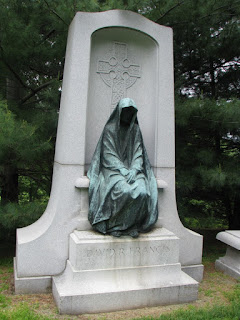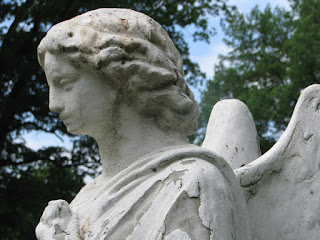The time of choosing what I do with my time is nearing an end, until August at least. Of course, there are millions of moments to look forward to in the summer with my Sophia. However, I am trying to take advantage of the days I have left. Lots of long walks and one venture to a place that's been on my list for a very long time: Bellefontaine (pronounced Belle Fountain) Cemetery.
The cemetery offers a tangible walk through the history of St. Louis. The people with the mansions in the city and the sprawling ranches in the country also have the biggest monuments in Bellefontaine. However, there are also monuments built on love and longing, not built to impress but to honor. And there are reminders of where we've been and what's still possible.
I'll start with the creepiest. Yes, I'm sure I could say that more eloquently. But, truthfully, it was creepy. David Francis was the President of the Louisiana Purchase Exposition (1904 World's Fair). He was also Ambassador to Russia during the 1917 Russian Revolution. Perhaps that's why he felt a connection to the darker element of the spiritual world? Perhaps this figure is simply guardian of his family's remains. Regardless, it's an intense and moving figure. Beautiful.
Also very creepy...
Most people chose to go with the uplifting angelic representation. Many, many ethereal and memorable sculptures. Here are just a few.
It was truly a walk through St. Louis, and American, history. Many people who are buried here helped to change the course of our history. And that's no exaggeration.
In the very back, you will find the monument to William Clark, of Lewis and Clark. It's an impressive monument and is surrounded by those of his descendants. It is also flanked by two people whose epitaphs indicate they were his (beloved) servants, although it's more likely that they were slaves. Yet another reminder of the complications of our national story.
A monument that holds a prominent position today, although probably not as prominent as when it was built, is the mausoleum of Adolphus Busch. The inscription above the door is "Veni, Vidi, Vici", and indeed he did.
There is another element of history that is well represented in Bellefontaine, and I was unaware of this until my visit. The cemetery is now the resting place of several prominent Suffragettes. I was happy to pay homage to some of these brave and tireless agents of change. Virginia Minor attempted to register to vote in 1872, claiming the 14th amendment gave every woman the rights of a citizen of the United States. She took her case before the courts and lost, but she never gave up the fight. It took nearly fifty more years for women to gain the right to vote, long after Virginia was gone.
Edna Fischel Gellhorn, on the other hand, did get to vote. She was born six years after Virginia Minor first tried to gain rights for women, and Edna joined the cause at a young age. After the 19th amendment's passage, she became Vice President of the National League of Women Voters and joined Eleanor Roosevelt in the United Nations Association.
Here stands their monument. Desperate or hopeful? Probably both. As powerful as love.











No comments:
Post a Comment